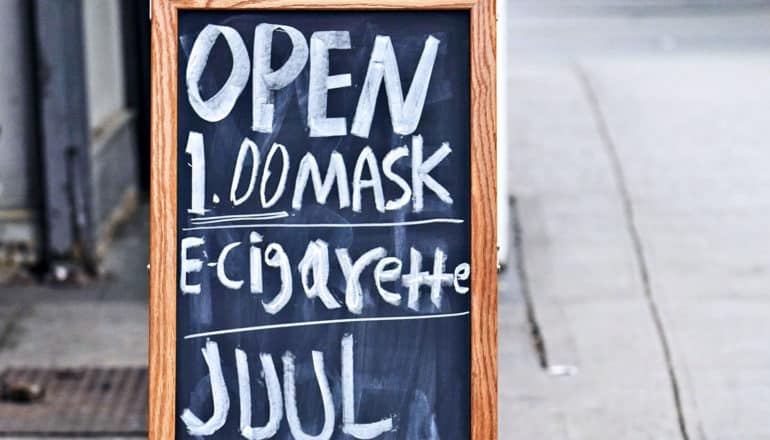
Teenagers and young adults who vape face a much higher risk of COVID-19 than their peers who do not vape, according to new research.
The study is believed to be the first to examine connections between youth vaping and COVID-19 using US population-based data collected during the pandemic.
“We need to tell everyone: If you are a vaper, you are putting yourself at risk for COVID-19 and other lung disease.”
Among young people tested for the virus that causes COVID-19, researchers found that teens who vaped were five to seven times more likely to be infected than those who did not use e-cigarettes.
“Teens and young adults need to know that if you use e-cigarettes, you are likely at immediate risk of COVID-19 because you are damaging your lungs,” says Bonnie Halpern-Felsher, professor of pediatrics at Stanford University and senior author of the paper in the Journal of Adolescent Health.
Big increase in risk for teens who vape
“Young people may believe their age protects them from contracting the virus or that they will not experience symptoms of COVID-19, but the data show this isn’t true among those who vape,” says postdoctoral scholar Shivani Mathur Gaiha, the paper’s lead author.
“This study tells us pretty clearly that youth who are using vapes or are dual-using [e-cigarettes and cigarettes] are at elevated risk, and it’s not just a small increase in risk; it’s a big one.”
Researchers collected data via online surveys conducted in May. Researchers had 4,351 participants ages 13 to 24 who lived in all 50 US states, the District of Columbia, and three US territories complete the survey. The researchers recruited a sample of participants evenly divided between those who had used e-cigarettes and those who had never used nicotine products. The sample also included approximately equal numbers of people in different age groups (adolescent, young adult, and adult), races, and genders.
Participants answered questions about whether they had ever used vaping devices or combustible cigarettes, as well as whether they had vaped or smoked in the past 30 days. The survey asked if they had experienced COVID-19 symptoms, received a test for COVID-19, or received a positive diagnosis of COVID-19.
Researchers adjusted the results for confounding factors such as age, sex, LGBTQ status, race/ethnicity, mother’s level of education, body mass index, compliance with shelter-in-place orders, rate of COVID-19 diagnosis in the states where the participants were residing, and state and regional trends in e-cigarette use.
Tighter regulations may help
Young people who had used both cigarettes and e-cigarettes in the previous 30 days were almost five times as likely to experience COVID-19 symptoms, such as coughing, fever, tiredness, and difficulty breathing as those who never smoked or vaped.
This may explain why they were also more likely to receive COVID-19 testing, says Halpern-Felsher, especially given that in May, many regions limited COVID-19 testing to people with symptoms.
Depending on which nicotine products they used and how recently they had used them, young people who vaped or smoked, or both, were 2.6 to nine times more likely to receive COVID-19 tests than nonusers.
Among the participants tested for COVID-19, those who had ever used e-cigarettes were five times more likely to be diagnosed with COVID-19 than nonusers. Those who had used both e-cigarettes and conventional cigarettes in the previous 30 days were 6.8 times more likely to be diagnosed with the disease.
The researchers did not find a connection between COVID-19 diagnosis and smoking conventional cigarettes alone, perhaps because the prevalent pattern among youth is to use both vaping devices and traditional cigarettes. Other research has shown that nearly all nicotine-using youth vape, and some also smoke cigarettes, but very few use cigarettes only, Halpern-Felsher says.
In line with other recent COVID-19 research, the study shows that lower socioeconomic status and Hispanic or multiracial ethnicity were linked to a higher risk of being diagnosed with the disease.
In addition to warning teenagers and young adults about the dangers of vaping, the researchers hope their findings will prompt the Food and Drug Administration to further tighten regulations governing how vaping products are sold to young people.
“Now is the time,” Halpern-Felsher says. “We need the FDA to hurry up and regulate these products. And we need to tell everyone: If you are a vaper, you are putting yourself at risk for COVID-19 and other lung disease.”
A statistician at the University of California, San Francisco also contributed to the research. Funding for the research came from the Taube Research Faculty Scholar Endowment; the National Heart, Lung and Blood Institute; and the Food and Drug Administration Center for Tobacco Products.
Source: Stanford University
The post Teens who vape face much higher risk of COVID-19 appeared first on Futurity.
from Futurity https://ift.tt/3h1aonm
No comments:
Post a Comment